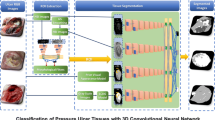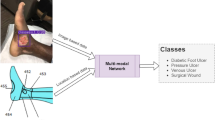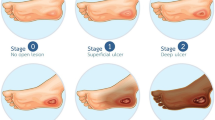Abstract
Pressure ulcers are a common, painful, costly, and often preventable complication associated with prolonged immobility in bedridden patients. It is a significant health problem worldwide because it is frequently seen in inpatients and has high treatment costs. For the treatment to be effective and to ensure an international standardization for all patients, it is essential that the diagnosis of pressure ulcers is made in the early stages and correctly. Since invasive methods of obtaining information can be painful for patients, different methods are used to make a correct diagnosis. Image-based diagnosis method is one of them. By using images obtained from patients, it will be possible to obtain successful results by keeping patients away from such painful situations. At this stage, disposable wound rulers are used in clinical practice to measure the length, width, and depth of patients’ wounds. The information obtained is then entered into tools such as the Braden Scale, the Norton Scale, and the Waterlow Scale to provide a formal assessment of risk for pressure ulcers. This paper presents a novel benchmark dataset containing pressure ulcer images and a semi-two-stream approach that uses the original images and the cropped wound areas together for diagnosing the stage of pressure ulcers. Various state-of-the-art convolutional neural network (CNN) architectures are evaluated on this dataset. Our experimental results (test accuracy of 93%, the precision of 93%, the recall of 92%, and the F1-score of 93%) show that the proposed semi-two-stream method improves recognition results compared to the base CNN architectures.







Similar content being viewed by others
Data Availibility
Data is available on request from the authors.
References
Strazzieri-Pulido, K.C., Peres, G.R.P., Campanili, T.C.G.F., Gouveia Santos, V.L.C.: Incidence of skin tears and risk factors. Journal of Wound, Ostomy and Continence Nursing 44(1), 29–33 (2017)
Au, Y., Wang, S.C.: Financial and clinical risk evaluation of pressure injuries in us hospitals: A business case for initiating quality improvement. Wounds: a Compendium of Clinical Research and Practice 31(5), 123–126 (2019)
Padula, W.V., Delarmente, B.A.: The national cost of hospital-acquired pressure injuries in the united states. International Wound Journal 16(3), 634–640 (2019) https://doi.org/10.1111/iwj.13071
Gould, L.J., Bohn, G., Bryant, R., Paine, T., Couch, K., Cowan, L., McFarland, F., Simman, R.: Pressure ulcer summit 2018: An interdisciplinary approach to improve our understanding of the risk of pressure-induced tissue damage. Wound Repair and Regeneration 27(5), 497–508 (2019)
Khojastehfar, S., Ghezeljeh, T.N., Haghani, S.: Factors related to knowledge, attitude, and practice of nurses in intensive care unit in the area of pressure ulcer prevention: a multicenter study. Journal of tissue viability 29(2), 76–81 (2020)
Stephens, M., Bartley, C.: Understanding the association between pressure ulcers and sitting in adults what does it mean for me and my carers? seating guidelines for people, carers and health & social care professionals. Journal of tissue viability 27(1), 59–73 (2018)
Delmore, B., Deppisch, M., Sylvia, C., Luna-Anderson, C., Nie, A.M.: Pressure injuries in the pediatric population: a national pressure ulcer advisory panel white paper. Advances in Skin & Wound Care 32(9), 394–408 (2019)
The prevalence of pressure ulcer and hospital acquired pressure ulcer in hospitalized patients in china: a meta-analysis. Chinese Nursing Management 18(7), 907 (2018) https://doi.org/10.3969/j.issn.1672-1756.2018.07.011
Biçer, E.K., Güçlüel, Y., Türker, M., Kepiçoglu, N.A., Sekerci, Y.G., Say, A.: Pressure ulcer prevalence, incidence, risk, clinical features, and outcomes among patients in a turkish hospital: a cross-sectional, retrospective study. Wound Manag Prev 65(2), 20–28 (2019)
Ghali, H., Rejeb, B., Chelly, S., Cheikh, A.B., Khefacha, S., Latiri, H.: Incidence and risk factors of pressure ulcers in a tunisian university hospital. Rev Epidemiol Sante Publique 66(Supl 5), 340 (2018)
Pacific, P.: Prevention and treatment of pressure ulcers: quick reference guide. National Pressure Ulcer Advisory Panel 75 (2014)
Demircan, F.: Basınç ülserlerinin önlenmesi için yeni bir matematiksel model geliştirilmesi ve uygulanması (2018)
Yazgan, E.O.: In: Özyer, Y. (ed.) Basınç Yarası. Akademisyen Kitabevi
Ay, B., Tasar, B., Utlu, Z., Ay, K., Aydin, G.: Deep transfer learning-based visual classification of pressure injuries stages. Neural Computing and Applications 34(18), 16157–16168 (2022)
Cicceri, G., De Vita, F., Bruneo, D., Merlino, G., Puliafito, A.: A deep learning approach for pressure ulcer prevention using wearable computing. Human-centric Computing and Information Sciences 10(1), 1–21 (2020)
Mervis, J.S., Phillips, T.J.: Pressure ulcers: Prevention and management. Journal of the American Academy of Dermatology 81(4), 893–902 (2019)
García-Zapirain, B., Elmogy, M., El-Baz, A., Elmaghraby, A.S.: Classification of pressure ulcer tissues with 3d convolutional neural network. Medical & biological engineering & computing 56, 2245–2258 (2018)
Liu, T.J., Christian, M., Chu, Y.-C., Chen, Y.-C., Chang, C.-W., Lai, F., Tai, H.-C.: A pressure ulcers assessment system for diagnosis and decision making using convolutional neural networks. Journal of the Formosan Medical Association 121(11), 2227–2236 (2022)
Rostami, B., Anisuzzaman, D., Wang, C., Gopalakrishnan, S., Niezgoda, J., Yu, Z.: Multiclass wound image classification using an ensemble deep cnn-based classifier. Computers in Biology and Medicine 134, 104536 (2021)
Elmogy, M., García-Zapirain, B., Burns, C., Elmaghraby, A., Ei-Baz, A.: Tissues classification for pressure ulcer images based on 3d convolutional neural network. In: 2018 25th IEEE International Conference on Image Processing (ICIP), pp. 3139–3143 (2018). IEEE
Elmogy, M., García-Zapirain, B., Elmaghraby, A.S., El-Baz, A.: An automated classification framework for pressure ulcer tissues based on 3d convolutional neural network. In: 2018 24th International Conference on Pattern Recognition (ICPR), pp. 2356–2361 (2018). IEEE
Rajathi, V., Bhavani, R., Wiselin Jiji, G.: Varicose ulcer (c6) wound image tissue classification using multidimensional convolutional neural networks. The Imaging Science Journal 67(7), 374–384 (2019)
Chang, D.-H., Chu, P.-J., Li, Y.-J., Ning, C.-K., Chien, T.-Y.: A clinical decision support system of pressure ulcers tissue classification. In: Proceedings of the 5th International Conference on Medical and Health Informatics, pp. 338–343 (2021)
Zahia, S., Sierra-Sosa, D., Garcia-Zapirain, B., Elmaghraby, A.: Tissue classification and segmentation of pressure injuries using convolutional neural networks. Computer methods and programs in biomedicine 159, 51–58 (2018)
Rother, C., Kolmogorov, V., Blake, A.: “grabcut” interactive foreground extraction using iterated graph cuts. ACM transactions on graphics (TOG) 23(3), 309–314 (2004)
Silva, R.H.L., Machado, A.M.C.: Automatic measurement of pressure ulcers using support vector machines and grabcut. Computer Methods and Programs in Biomedicine 200, 105867 (2021)
Chae, J., Hong, K.Y., Kim, J.: A pressure ulcer care system for remote medical assistance: residual u-net with an attention model based for wound area segmentation. arXiv preprint arXiv:2101.09433 (2021)
Chang, C.W., Christian, M., Chang, D.H., Lai, F., Liu, T.J., Chen, Y.S., Chen, W.J.: Deep learning approach based on superpixel segmentation assisted labeling for automatic pressure ulcer diagnosis. Plos one 17(2), 0264139 (2022)
Oota, S.R., Rowtula, V., Mohammed, S., Galitz, J., Liu, M., Gupta, M.: A deep multi-modal method for patient wound healing assessment (2019)
Anisuzzaman, D., Patel, Y., Rostami, B., Niezgoda, J., Gopalakrishnan, S., Yu, Z.: Multi-modal wound classification using wound image and location by deep neural network. Scientific Reports 12(1), 20057 (2022)
Anisuzzaman, D., Patel, Y., Niezgoda, J., Gopalakrishnan, S., Yu, Z.: Wound severity classification using deep neural network. arXiv preprint arXiv:2204.07942 (2022)
Anisuzzaman, D., Patel, Y., Niezgoda, J.A., Gopalakrishnan, S., Yu, Z.: A mobile app for wound localization using deep learning. IEEE Access 10, 61398–61409 (2022)
Yilmaz, B., Atagün, E., Demırcan, F.Ö., Yücedağ, İ.: Classification of pressure ulcer images with logistic regression. In: 2021 International Conference on INnovations in Intelligent SysTems and Applications (INISTA), pp. 1–6 (2021). IEEE
Fergus, P., Chalmers, C., Henderson, W., Roberts, D., Waraich, A.: Pressure ulcer categorisation using deep learning: A clinical trial to evaluate model performance. arXiv preprint arXiv:2203.06248 (2022)
Krizhevsky, A., Sutskever, I., Hinton, G.E.: Imagenet classification with deep convolutional neural networks. Communications of the ACM 60(6), 84–90 (2017)
Huang, G., Liu, Z., Van Der Maaten, L., Weinberger, K.Q.: Densely connected convolutional networks. In: Proceedings of the IEEE Conference on Computer Vision and Pattern Recognition, pp. 4700–4708 (2017)
Tan, M., Le, Q.: Efficientnet: Rethinking model scaling for convolutional neural networks. In: International Conference on Machine Learning, pp. 6105–6114 (2019). PMLR
Szegedy, C., Liu, W., Jia, Y., Sermanet, P., Reed, S., Anguelov, D., Erhan, D., Vanhoucke, V., Rabinovich, A.: Going deeper with convolutions. In: Proceedings of the IEEE Conference on Computer Vision and Pattern Recognition, pp. 1–9 (2015)
Sandler, M., Howard, A., Zhu, M., Zhmoginov, A., Chen, L.-C.: Mobilenetv2: Inverted residuals and linear bottlenecks. In: Proceedings of the IEEE Conference on Computer Vision and Pattern Recognition, pp. 4510–4520 (2018)
He, K., Zhang, X., Ren, S., Sun, J.: Deep residual learning for image recognition. In: Proceedings of the IEEE Conference on Computer Vision and Pattern Recognition, pp. 770–778 (2016)
Simonyan, K., Zisserman, A.: Very deep convolutional networks for large-scale image recognition. arXiv preprint arXiv:1409.1556 (2014)
Zalluhoglu, C., Ikizler-Cinbis, N.: Region based multi-stream convolutional neural networks for collective activity recognition. Journal of Visual Communication and Image Representation 60, 170–179 (2019)
Girshick, R.: Fast r-cnn. In: Proceedings of the IEEE International Conference on Computer Vision, pp. 1440–1448 (2015)
Selvaraju, R.R., Cogswell, M., Das, A., Vedantam, R., Parikh, D., Batra, D.: Grad-cam: Visual explanations from deep networks via gradient-based localization. In: 2017 IEEE International Conference on Computer Vision (ICCV), pp. 618–626 (2017). https://doi.org/10.1109/ICCV.2017.74
Author information
Authors and Affiliations
Contributions
Conceptualization and model design were performed by CZ, MSG, and EAS. Material preparation, data collection, and analysis were performed by DA, DK, MMÜ, KA, and AOB. The first draft of the manuscript was written by CZ, and all authors commented on previous versions of the manuscript. All authors read and approved the final manuscript.
Corresponding author
Ethics declarations
Ethics Approval
Approval was granted by the Ethics Committee of Pursaklar State Hospital (Ankara, Turkey) (date, May 05, 2023).
Consent to Participate
Informed consent was obtained from all individual participants included in the study.
Consent for Publication
The authors affirm that human research participants provided informed consent for publication.
Competing Interests
The authors declare no competing interests
Additional information
Publisher's Note
Springer Nature remains neutral with regard to jurisdictional claims in published maps and institutional affiliations.
Rights and permissions
Springer Nature or its licensor (e.g. a society or other partner) holds exclusive rights to this article under a publishing agreement with the author(s) or other rightsholder(s); author self-archiving of the accepted manuscript version of this article is solely governed by the terms of such publishing agreement and applicable law.
About this article
Cite this article
Zalluhoğlu, C., Akdoğan, D., Karakaya, D. et al. Region-Based Semi-Two-Stream Convolutional Neural Networks for Pressure Ulcer Recognition. J Digit Imaging. Inform. med. 37, 801–813 (2024). https://doi.org/10.1007/s10278-023-00960-4
Received:
Revised:
Accepted:
Published:
Issue Date:
DOI: https://doi.org/10.1007/s10278-023-00960-4




